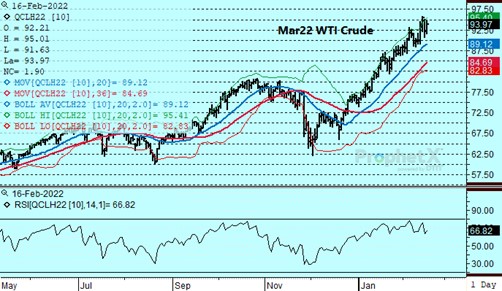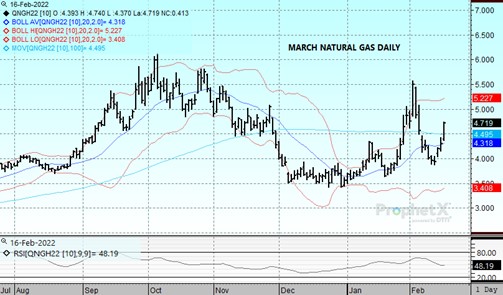by Stephen Platt and Mike McElroy
Price Overview
Prices rose toward the 95.00 level basis March WTI before retreating late in the session. Conflicting statements with respect to Russian actions near Ukraine continued to exacerbate a volatile trading environment, with yesterday’s announcement of small troop withdrawals countered by analysts suggesting there were signs that Russia was continuing its troop build-up. Potential for sanctions on Russian exports by Western powers continues to prompt a sense of nervousness toward global energy supplies. The DOE report had little impact on the market as any negative reaction to the larger than expected build was offset by ongoing declines in stocks at Cushing along with strong rates of disappearance. Generally ignored was the resumption of Iranian negotiations toward the lifting of sanctions.
The DOE report showed crude inventories rose by 1.1 mb against expectations for a 1.6 decline. Crude stocks at Cushing fell by 1.9 to 25.8 mb, their lowest since September of 2018. US gasoline stocks were off by 1.3 mb while distillate declined 1.6. Total stocks of crude and products fell by 9.9 mb with propane inventories falling by 5.9 mb. Supportive to values were record implied disappearance rates of 22.7 compared to 21.9 mb in the prior week. Refinery utilization was low, falling to 85.3 percent compared to 88.2 last week.
The uncertain environment with respect to Ukraine remains the dominant force moving the market. Crude differentials have strengthened dramatically, with spot Dubai reaching a premium of 4.15 today as major consumers seek prompt cargoes in the event of a disruption of Russian shipments. At this juncture, given the landslide of news developments, swings in the market are likely to continue to be fast and furious. Although a resolution to the crisis is certainly possible, the range of outcomes is difficult to predict and harder still to discern their eventual global economic impact. Even a peaceful resolution is hard to assess given the positive effect on longer term economic activity in relation to how quickly OPEC addresses shortfalls from their production targets.


Natural Gas
It appears as though the reports of winter’s end have been greatly exaggerated. The switch toward a colder trend into late February that we started to see early this week has continued to strengthen, with this mornings runs adding 40-50 bcf of demand to the 15 day forecasts. The turnaround has forced trade to reestablish some risk premium that it so willingly threw away over the last two weeks. Add to that some winter storm potential for the central and eastern US in the next 10 days and the magnitude of the buying is not surprising considering the possibility of increased demand and production shut-ins. Estimates for tomorrow’s withdrawl are in the 193 area compared to the 5 year average at 154. The market retraced 50 percent of the early February break, and the close near the highs likely signals followthrough that would target a 68 percent retracement in the 4.93 area. Once again the speed of the move higher has amplified the downside risk if the cooling trend reverses, with 4.50 the initial area of support.
Futures and options trading involve significant risk of loss and may not be suitable for everyone. Therefore, carefully consider whether such trading is suitable for you in light of your financial condition. The information and comments contained herein is provided by ADMIS and in no way should be construed to be information provided by ADM. The author of this report did not have a financial interest in any of the contracts discussed in this report at the time the report was prepared. The information provided is designed to assist in your analysis and evaluation of the futures and options markets. However, any decisions you may make to buy, sell or hold a futures or options position on such research are entirely your own and not in any way deemed to be endorsed by or attributed to ADMIS. Copyright ADM Investor Services, Inc.
